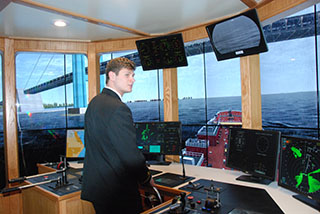A thunderstorm was gathering over New York Harbor, and on the bridge of an ATB, cadets from the State University of New York Maritime College watched their instrument array and the approach of a ro/ro vehicle carrier.
“Securite, securite, this is the Danielle Bouchard,” cadet Kameron Knight called on the loudhailer, his voice booming in the wheelhouse. The pounding sound of rotor blades interrupted, as a Coast Guard helicopter cruised past low.
Then came the virtual rain and thunder.
“You can see the rain impacts the radar, so they have to adjust the radar,” SUNY Maritime professor Eric Johannson said, sticking his head in the wheelhouse door.
“You realize all this was not around years ago. It was just a radar and a hard chart,” said Morton Bouchard III, watching from a corner of the state of the art tug and barge simulator that Bouchard Transportation Co., Melville, N.Y., is supporting at the Bronx, N.Y., college.
Bouchard received an honorary doctorate degree Friday at SUNY Maritime’s winter commencement, in honor of his contributions to the school and the industry. The $750,000 simulator, now only in its second semester of operation, will soon be enlarged with consoles to simulate two Class B tug bridges, with controls to practice for tractor and conventional tug operations.
“This has been the best thing that ever happened,” said Johansson, a former tug captain and professor of marine transportation who has taught at SUNY Maritime for 20 years.
With its wrap-around flat panels, the Bouchard simulator creates a virtual reality of different vessels and harbors – up to 14 waterways now, with more on the way thanks to continuing software and chart upgrades supplied by Bouchard.
“Every year we’ve got to upgrade it. That was part of the commitment we made,” Bouchard said. Harbors in the database now are from Boston to Houston, and the latest upgrade added the Mississippi River from the Southwest Pass to Baton Rouge, La.
The programming models tugs of 4,000 hp, 6,000 hp and 10,000 hp, both in articulated and towing modes. A major technical advance of the simulator is modeling the barges as independently moving vessels. The articulation is clearly seen – and felt – by watching the motion on the display, so effective that visitors sometimes need to hold on for comfort, Johannson said.
“The real-world graphics are immaculate,” cadet Bryan Hinton said, as the virtual ATB made is way south toward the Verrazano Narrows. “You can go down there past Brooklyn and Staten Island, and see the real thing.”
Knight said he’s found the simulator training is even more valuable than cadets’ summer work on the water, which can be repetitive and not particularly challenging.
Bouchard said he saw the need for a best-of-class simulator for the industry, especially with the pace of technology and growth of ATBs to 260,000 bbls. His company is christening a new pair of tug-barges in mid-February and has two more on the way. “We have a lot of openings,” he told the cadets.
Bouchard captains help set up the simulator, advising and adjusting controls for maximum realism, and the virtual bridge will be training career mariners as well as cadets.
“It will be open to all our competitors,” Bouchard said. “More importantly, to the next generation of mariners coming up.”




